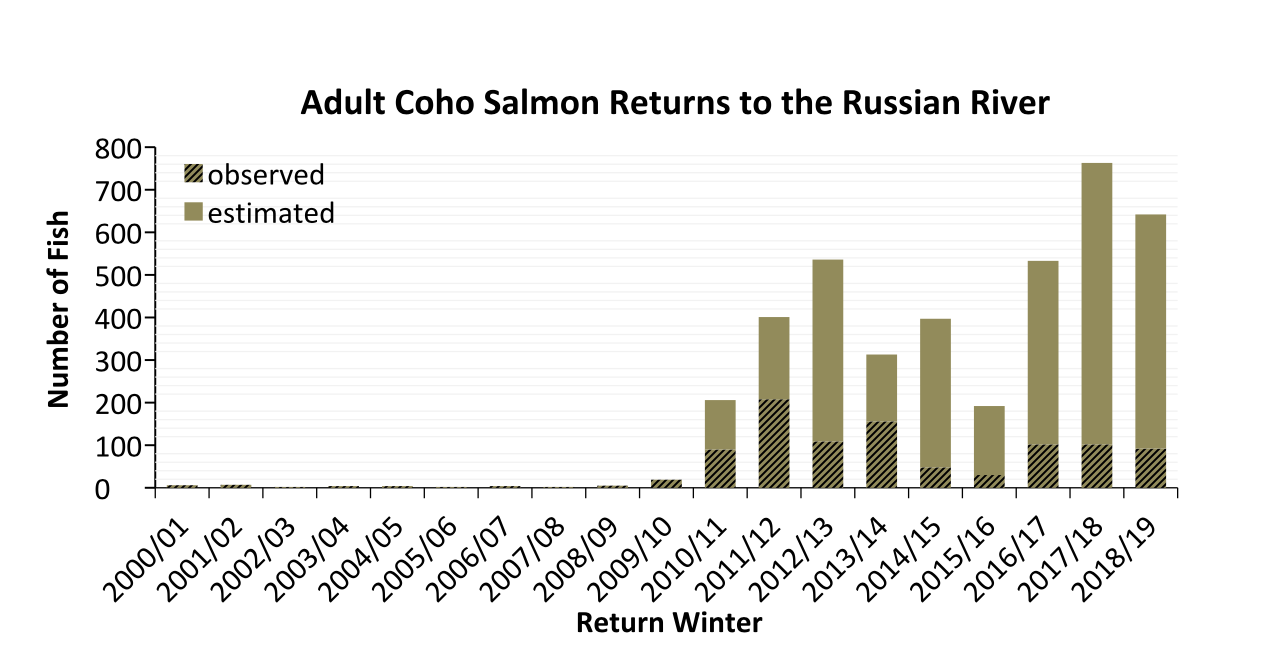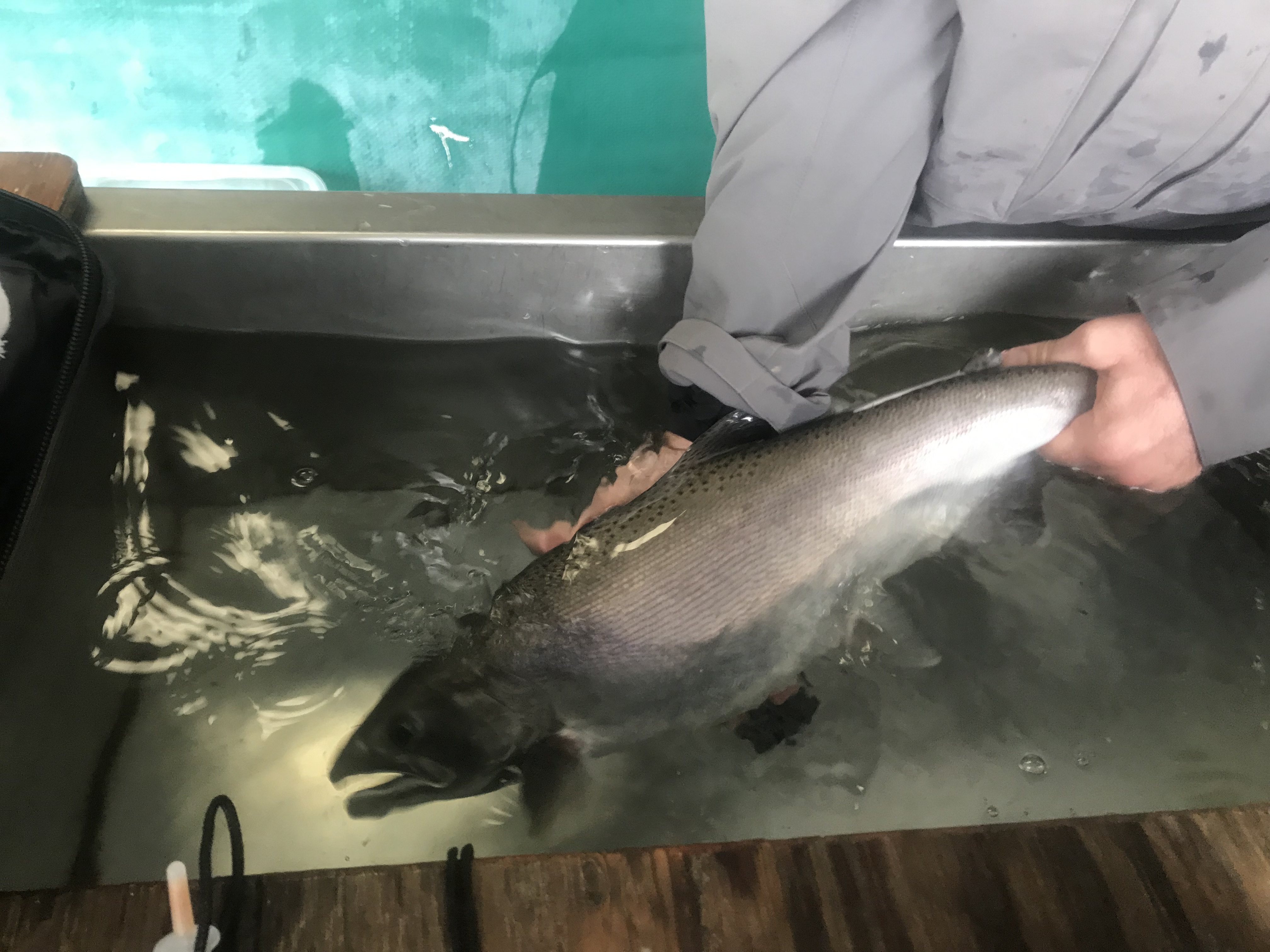By Zac Reinstein
February 13, 2020
In the Pacific Northwest, fish hatcheries have gained a bad rap for their effects on native salmon. The idea that we can degrade fish habitat and make up for it by supplementing wild populations with hatchery stock has been pushed around the world for over a hundred years, but recent research has proven this concept to be false. In the majority of the cases where hatchery fish are stocked on top of wild fish, fewer adult fish return than anticipated. Ray Hilborn, a fisheries biologist with Washington Sea Grant, wrote “…hatchery programs that attempt to add additional fish to existing healthy wild stocks are ill advised and highly dangerous.”
But what about when wild stocks have already collapsed?

In the late 1990s, coho salmon (Oncorhynchus kisutch) in California’s Russian River were on the brink of extinction. Once a great fishery of the state, these runs had dropped from tens of thousands to just a handful of fish. By 2000, biologists estimated that fewer than ten adults were returning to the basin annually. On September 11, 2001, an effort began to collect the last remaining juveniles from drying pools in one of the few streams where they were found. A couple hundred young-of-the-year were captured and relocated to the Don Clausen Fish Hatchery at Warm Springs Dam. These fish became the basis of the Russian River Coho Salmon Captive Broodstock Program. The program raised these juveniles to adulthood and spawned them at the facility. In 2004 their offspring were planted in historical coho streams in the southern portion of the basin—a practice that has continued each year since.The 2001 collection effort was essentially responsible for salvaging the Russian River coho salmon genetic pool. Within a week, the majority of the pools where the fish had been found had dried and almost all of the remaining wild fish had perished.
Unlike many production hatcheries, the goal of the Russian River’s conservation hatchery is to raise and release native coho salmon in hopes of re-establishing a self-sustaining, wild population. Due to its unique objective, the program has adopted a set of practices that are aligned with conserving endangered salmon, rather than producing fish for commercial and sport fishing.
Most production hatcheries spawn fish in large batches, often mixing gallons of eggs and fish sperm from many females and males. While this is quick and cost-effective, it degrades genetic integrity. To ensure the greatest possible diversity, the broodstock program uses advanced technology and analysis. NOAA’s Southwest Fisheries Science Center genotypes each broodfish and the broodstock program spawns according to this matrix, which pairs the most distantly-related individuals. Because of the limited genetic diversity remaining in the Russian River, they also incorporated fish from Olema Creek in Marin County (in the same Evolutionary Significant Unit) . This helped alleviate genetic bottlenecks while staying as close to local genetics as possible. Hatchery staff separates the eggs from each female into four bins, and each bin is spawned with a different furthest-related male. After hatching and growing into juveniles, the staff then loads portable backpacks and releases the fish into historical spawning tributaries. Natural selection can then act on these stocked fish, just like their wild counterparts.

Another innovative aspect of this conversation hatchery program is a robust field monitoring component, that we in California Sea Grant's Russian River Salmon and Steelhead Monitoring Program implement. We work with the hatchery to evaluate the effectiveness of program strategies and with resource managers to adaptively manage future releases.
Since the creation of the broodstock program, coho salmon adult returns to the Russian River basin have gone from tens of fish to hundreds of fish. While the Russian River is still a long way from recovery targets, the trend is generally moving in the right direction. Over the last three winters (2016/17 through 2018/19), we saw adult coho salmon and/or their nests, knows as redds, in 24 streams—up from only two in the early 2000s. 
Last winter (2018/19), the estimated return was 642 adult hatchery coho salmon. Unlike traditional hatchery efforts, the broodstock program wants fish to spawn in tributaries, instead of returning to the facility. Our hope is that the naturally-spawned offspring will adapt to current watershed conditions over time and will pass genetics to their offspring that allow them to thrive in local conditions.
Can a conservation hatchery recover a population on its own? Short answer; probably not. The fish populations in the Russian River have declined due to large-scale problems, like habitat loss, that must be resolved in conjunction with conservation hatchery efforts. Trout Unlimited’s Jack Williams wrote in a recent paper, “A new paradigm that advances habitat restoration and ecosystemfunction rather than hatchery production is needed for many of these stocks to survive and prosper into the next century.” Resource managers have made the decision to prevent the collapse of this keystone species, but our community must continue to work together to find innovative and multifaceted approaches to resolve lingering obstacles to recovering Russian River coho and other vulnerable salmon populations.
There are a few examples of conservation hatchery efforts successfully supporting species recovery. The majority of these examples revolve around landlocked trout populations such as
Greenback Cutthroat (Colorado), Bonneville Cutthroat (Idaho), Lahontan Cutthroat Trout (California/Nevada) and McCloud River Redband Trout (California). We hope that, one day, Russian River coho salmon will be added to this list; that the work we’re doing in the basin will not only reestablish our local coho salmon populations, but can serve as a model for other basins where wild populations are too small to recover on their own.






